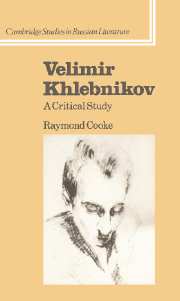4 - From warrior to prophet – the siege of the tower of time
Published online by Cambridge University Press: 12 September 2009
Summary
As early as 1904, in a self-styled epitaph ‘Let them read on a tombstone …’ (‘Pust' na mogil'noy plite prochtut …’) Khlebnikov had already outlined many of his future concerns. He included as one of his prospective achievements the fact that he had ‘linked time and space’ (NP 318). Many years later, not long before his death, Khlebnikov testified to the strength of this prediction, announcing in his ‘Boards of Fate’ that he had provided ‘a quantitative link between the principles of time and space’ (SS III 477).
The nature of the relationship between these two principles was for long a major preoccupation. Khlebnikov was concerned at the neglect that the study of time was suffering. Time, in his view, was a ‘Cinderella’ (SS III 443); it was a ‘serf’ (SP v 105), a ‘kitchen boy’ in the service of space. Khlebnikov wished to correct the imbalance. He wished to find physical laws which operated in the ‘state of time’ just as they did in the ‘states of space’. He saw the movement of time ‘visually’ (SS III 473). He had, in effect, a vision of time as a kind of three-dimensional entity, ‘a vision of time in stone’ (SP v 104). Osip Mandelstam formulated this dimensional synaesthesia succinctly when he spoke of Khlebnikov as, ‘a kind of idiotic Einstein, unable to distinguish which was nearer – a railway bridge or the Lay of Igor's Campaign’.
- Type
- Chapter
- Information
- Velimir KhlebnikovA Critical Study, pp. 104 - 160Publisher: Cambridge University PressPrint publication year: 1987

